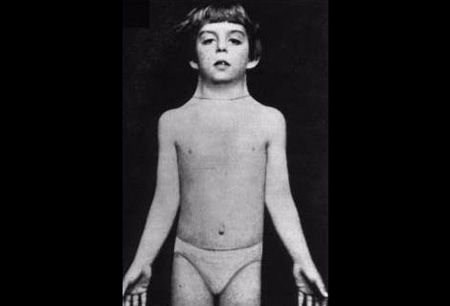Resumo
Definição
História e exame físico
Principais fatores diagnósticos
- poor growth
- short stature
- delayed/absent pubertal development
- primary amenorrhea
- congenital heart defects
- skeletal abnormalities
- webbed neck
- peripheral lymphedema
Outros fatores diagnósticos
- dysmorphic features
- secondary amenorrhea
- multiple melanocytic nevi
- recurrent/severe otitis media
- systolic ejection murmur and/or click
- poor social skills
- eye abnormalities
- upper extremity hypertension
- dystrophic and/or hyperconvex nails
Fatores de risco
- there are no known risk factors
Investigações diagnósticas
Primeiras investigações a serem solicitadas
- karyotype
Investigações a serem consideradas
- audiology testing
- ophthalmological examination
- bone age
- echocardiogram
- cardiac MRI
- serum follicle-stimulating hormone and anti-Müllerian hormone
- skeletal survey
- pelvic ultrasound
- renal ultrasound
- thyroid function tests
- antithyroid antibodies
- LFTs/gamma glutamyl transferase/alkaline phosphatase
- fasting glucose and HbA1c
- serum lipids
- IgA level and tissue transglutaminase IgA
- vitamin D levels
Algoritmo de tratamento
all patients: at diagnosis
all patients: after establishment of cyclical bleeding
Colaboradores
Autores
Patricia Y. Fechner, MD
Medical Director
Differences of Sex Development Program
Medical Director Congenital Adrenal Hyperplasia (CAH) Center of Excellence
Medical Co-Director Turner Syndrome Clinic
Seattle Children’s Hospital
Professor of Pediatrics
University of Washington
Seattle
WA
Declarações
PYF is currently considering research using growth hormone in Turner syndrome sponsored by industry but no contract has been signed. She has been invited to participate in the 2023 updated Guidelines for Turner Syndrome in June 2023. She has also conducted contract research from Neurocrine BioSciences, Pfizer, Spruce Biosciences, and Ascendis Pharma. PYF has stock in Abbott Laboratories and AbbVie. She declares that these activities do not relate to the topic. PYF participated in Meet the Professor for the Endocrine Society 2019 Annual Meeting and is an author of references cited in this topic.
Agradecimentos
Dr Patricia Y. Fechner would like to gratefully acknowledge Dr Carolyn A. Bondy, a previous contributor to this topic.
Declarações
CAB is an author of references cited in this topic.
Revisores
Gerard Conway, MD
Consultant Endocrinologist
University College London Hospitals
London
UK
Declarações
GC declares that he has no competing interests.
Peter Hindmarsh, MD
Professor
Developmental Endocrinology Research Unit
Institute of Child Health
London
UK
Declarações
PH declares that he has no competing interests.
Vaneeta Bamba, MD
Associate Professor of Pediatrics
Children’s Hospital of Philadelphia and the Perelman School of Medicine at the University of Pennsylvania
Philadelphia
PA
Declarações
VB declares that in Nov 2020, she was part of a Genetic Short Stature Advisory Board sponsored by NovoNordisk. VB is a member of the Turner Syndrome Society Scientific Advisory Board- this is not compensated. VB has no known upcoming financial interests or relationships.
Créditos aos pareceristas
Os tópicos do BMJ Best Practice são constantemente atualizados, seguindo os desenvolvimentos das evidências e das diretrizes. Os pareceristas aqui listados revisaram o conteúdo pelo menos uma vez durante a história do tópico.
Declarações
As afiliações e declarações dos pareceristas referem--se ao momento da revisão.
Referências
Principais artigos
Gravholt CH, Andersen NH, Conway GS; International Turner Syndrome Consensus Group. Clinical practice guidelines for the care of girls and women with Turner syndrome: proceedings from the 2016 Cincinnati International Turner Syndrome Meeting. Eur J Endocrinol. 2017;177:G1-G70.Texto completo Resumo
Bondy CA. Heart disease in Turner syndrome. Minerva Endocrinol. 2007;32:245-261. Resumo
Silberbach M, Roos-Hesselink JW, Andersen NH, et al. Cardiovascular health in Turner syndrome: a scientific statement from the American Heart Association. Circ Genom Precis Med. 2018 Oct;11(10):e000048.Texto completo Resumo
Canadian Growth Hormone Advisory Committee. Impact of growth hormone supplementation on adult height in Turner syndrome: results of the Canadian randomized controlled trial. J Clin Endocrinol Metab. 2005;90:3360-3366.Texto completo Resumo
Matura LA, Ho VB, Rosing DR, et al. Aortic dilatation and dissection in Turner syndrome. Circulation. 2007;116:1663-1670.Texto completo Resumo
Artigos de referência
Uma lista completa das fontes referenciadas neste tópico está disponível para os usuários com acesso total ao BMJ Best Practice.

Diagnósticos diferenciais
- Constitutional delay of growth and development
- Noonan syndrome
- 46,XX gonadal dysgenesis
Mais Diagnósticos diferenciaisGuidelines
- Cardiovascular health in Turner syndrome
- Clinical practice guidelines for the care of girls and women with Turner syndrome
Mais GuidelinesLog in or subscribe to access all of BMJ Best Practice
Use of this content is subject to our disclaimer